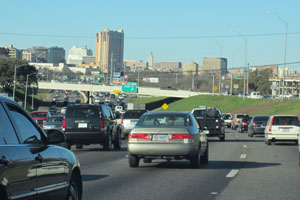Study Says Trucks Aren't to Blame for Congestion in Austin

ICYMI: Yesterday we released news on our Austin traffic analysis study looking at I-35 & SH 130. #congestion #roads http://t.co/P6VFLLBAqe
— TxA&M Trans Inst (@TTI) August 12, 2015
Interstate 35 in Austin, Texas, has been pegged as one of the nation's worst bottlenecks for traffic. But a new report says that contrary to perception, it's not large trucks that are at fault. The Transportation Policy Research Center at Texas A&M Transportation Institute has released a report that says only 14% of I-35 traffic volume is vehicles traveling through the region without stopping, and of that volume, only 1% are trucks.
The study was part of an effort to determine what incentives could be offered to encourage truckers to take the alternate toll road route of state Highway 130 around downtown Austin instead of I-35 through it. The bypass route is 11 miles longer.
Among several incentives considered — such as a higher speed limit, nearby amenities or toll discounts — the only one with merit, according to researchers, would be the allowance of Long Combination Vehicles on SH 130. The report says LCVs allow companies to transport more product on a trip, thereby offsetting some of the toll costs and making it a feasible alternative.
“This study supports short- and long-term mobility policy and planning strategies on how to move freight more efficiently in and through Texas," associate research scientist Tina Geiselbrecht said. "Although diverting truck traffic to uncongested toll roads is positive, the literature, traffic data and interviews revealed the trucking industry is reluctant to use tolled facilities. So it may be a good idea to also think about how to get passenger vehicles to divert to SH 130 since they make up the majority vehicle volume on I-35.
I-35 in Austin came in at No. 10 on the American Transportation Research Institute's 2014 ranking of the most congested freight corridors in the country.

